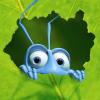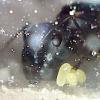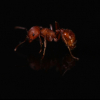Terry gave me a few more samples. One of Blue 100, Aqua 300, and Green 600.
My colonies and setups: (Note: my colonies were very close to hibernation when I started this, so results may not be as "normal" as I would like. Some colonies went into hibernation during the course of this test.)
Camponotus novaeboracensis - one colony, 110 workers, lots of larger larvae + pupae. Hummingbird nectar feeder available 24/7.
Campontous herculeanus - one colony, ~120 workers, lots of small and large larvae + pupae. Hummingbird nectar feeder available 24/7.
Lasius - one colony, 40+ workers, lots of brood, Hummingbird nectar feeder available 24/7.
Myrmica - 3 colonies, 2 species. Lots of brood. Ranging from 15-80 workers. 2 out of 3 have a hummingbird nectar feeder available 24/7. third is offered nectar 3 times weekly.
Formica ulkei - one colony, 30 workers, some brood. Hummingbird nectar feeder available 24/7.
Formica podzolica - 2 colonies, one with 5 workers, one with 15 workers. One with 15 workers has hummingbird nectar feeder available 24/7, one with 7 workers is offered nectar twice a week.
Tapinoma sessile - one colony: 3+ queens, 100+ workers, lots of brood. Hummingbird nectar feeder available 24/7. Offered live flightless fruit flies twice weekly.
Aphaenogaster 2 colonies, one with 2 workers, one with 6 workers. Offered hummingbird nectar 2-3 times a week.
Green 600: (6tsp of water as per paper instructions)
Lukewarm reception across the board.
First 15min:
Camponotus novaeboracensis - touched it with their antennae and are more or less ignoring it (they did not jump or have a strong reaction - resembled a lack a interest).
Campontous herculeanus - very slight feeding response. 1-2 workers are drinking out of 12 in the outworld - most examined it and are ignoring it.
Lasius - very slight feeding response (despite having no protein for almost a week and a fair bit of brood). 1-2 workers are drinking.
Myrmica - are taking a slight interest. Several workers are walking on it and tasting. Not as much excitement as when a mealworm piece is dropped, and not as much as the test batch.
Formica ulkei - showing some interest. 1-2 workers out of 8 in outworld are drinking.
Formica podzolica - showing some interest. Smaller colonies seem more unsure about it than larger ones.
Tapinoma sessile - slight feeding response of 2-3 workers drinking. Nothing close to the response I get from dropping in an actual insect.
Aphaenogaster (6 workers) - are ignoring it.
Additional smaller colonies of all species with less than 10 workers are showing no interest in it.
Aqua 300: (8tsp of water as per recommended online instructions)
Poor reception across the board.
First 15min:
Camponotusnovaeboracensis - touched it with their antennae and are completely ignoring it (they did not jump or have a strong reaction - just a lack a interest).
Camponotus herculeanus - smaller colonies are ignoring it. My colony of 100+ workers with lots of brood did eat some of it, but the response was not very enthusiastic.
Lasius - completely ignoring it after an initial inspection, despite lots of larvae in the nest.
Myrmica - are taking a slight interest. Several workers are walking on it and tasting. Much less interest than Green 600.
Formica ulkei - completely ignoring it after they attacked it and ensured it wasn't a threat.
Formica podzolica - all colonies are completely ignoring it.
Tapinoma sessile - slight feeding response of 5-6 workers drinking. This was the only colony to show more interest in the Aqua 300 than in the Green 600.
Aphaenogaster (6 workers) - are ignoring it.
Additional smaller colonies of all species with less than 10 workers are showing no interest in it.
All of my 5 Formica species are completely ignoring it and want nothing to do with it, which is unusual as at least one species will at least take some of any given food.
Blue 100
Just out of curiosity, before I mixed the blue batch I took a tiny amount of blue 100 powder (about the head of a pin worth). My large colony of Camponotus herculeanus took interest with about 10 foraging ants coming to check it out. Oddly enough, they would pick up a tiny crumb and start to walk - the crumbs never hit the garbage pile or made it into the nest. The ants carrying it seemed a bit confused once they started walking, and hid the crumbs in odd locations, under a rock, under the nectar feeder, along the wall joint, under the feeding plate. I have never seen them do this before. They have a very neat and tidy garbage pile.
Now the ants behavior really had my interest, I took another pin head sized bit of blue 100 powder and mixed it with an equal amount of hummingbird nectar (just mixed, didn't heat it). I had 4 ants suddenly converge on the slurry, drinking, and occasionally using their mandibles to mix it up for easier consumption. Considering they have a a liquid feeder with hummingbird nectar in it I was quite surprised that I had more interest in the blue/hummingbird nectar slurry than in the pure hummingbird nectar. Within 5 minutes the slurry was completely gone, with 8 ants carefully inspecting the feeding plate looking for more.
Next day, I mixed a pea sized amount of powder with hummingbird nectar and offered it to several other colonies. Immediate reaction was low to lukewarm, but after 5-10min the ants were much more receptive to it. Perhaps some chemical reaction?
Formica seemed pleased with it, with most foraging workers eating.
Myrmica preferred it after it had sat at least 10-15min, lukewarm response with 4-5 workers.
Camponotus herculeanus were not as enthusiastic as the first time, after 15min several workers were eating. Although most workers had gasters swollen with food, so that may have also had an effect.
Aphaenogaster (less than 10 workers) had about 1/3 of the workers enjoying it after it sat for 15-20 min.
Mixed half a package of Blue 100 according to the directions.
Camponotus novaeboracensis - touched it with their antennae and are completely ignoring it (they did not jump or have a strong reaction - just a lack a interest).
Camponotus herculeanus - smaller colonies are mostly ignoring it. My colony of 100+ workers with lots of brood did came back occasionally, but the response was not very enthusiastic.
Lasius - completely ignoring it after an initial inspection, despite lots of larvae in the nest.
Myrmica - One colony is completely ignoring it. 2 out of 3 colonies are taking a slight interest. Several workers are walking on it and tasting. Less interest than Aqua or Green.
Formica ulkei - go back occasionally, but are not that crazy about it.
Formica podzolica - Some response, but it isn't nearly as much as a mealworm would create.
Tapinoma sessile - slight feeding response of 5-6 workers drinking.
Aphaenogaster (6 workers) - 1 out of 2 colonies has one worker drinking.
By morning the only colonies still showing any interest were the large Camponotus herculeanus, Myrmica, and Tapinoma sessile. Not much interest, but the rest of the colonies are ignoring it.
Aqua 300 + hummingbird nectar: (8tsp of water as per recommended online instructions) After trying hummingbird nectar with blue 100 while dry, I went to mix Blue 100 with hummingbird nectar, but grabbed the wrong baggie...
Average reception for most colonies.
First 15min:
Camponotus novaeboracensis Seem to be trying to hibernate even on a heating cable (I am just awaiting the last 3 pupae to eclose). Almost no interest, 1 or 2 tasted, but that is it.
Camponotus herculeanus - My colony of 100+ workers with lots of brood is showing some interest. 3-4 workers out of 8 in the outworld are eating.
Lasius - slight interest. I think colony is almost ready to be put into hibernation.
Myrmica - are showing some interest. Less interest than Green 600, but more than pure Aqua 300
Formica ulkei - Showing some interest. The colonies in test tubes are showing more interest than those with outworld and nectar feeders available.
Formica podzolica - Showing some interest. The colonies in test tubes are showing more interest than those with outworld and nectar feeders available.
Tapinoma sessile - Best response I have ever seen with this colony. At least a dozen workers are always surrounding it. Even with a feeder with hummingbird nectar, this mix is getting far more interest.
Aphaenogaster (6 workers) - Showing slight interest.
Most of my colonies, including the small Camponotus colonies are all in hibernation.
After 5 hours, most of the colonies are burying it. Just the larger Formica podzolica colony, the Camponotus novaeboracensis colony, the larger Myrmica colony and the Tapinoma colony are still showing dim interest.
Blue 100 + hummingbird nectar: (8tsp of water as per recommended online instructions)
Low reception, less than the Aqua 300 mixed with nectar.
First 15min:
Camponotus herculeanus - My colony of 100+ workers with lots of brood is showing little interest. 1-2 workers out of 14 in the outworld are eating.
Lasius - little interest. This colony is ready for hibernation.
Myrmica - are showing some interest. Less interest than the Aqua 300 with hummingbird nectar. One 3 queen colony is ignoring it, while a second colony with one queen has about 6 workers attending it.
Formica ulkei - Showing little interest.
Formica podzolica - Showing little interest. The colonies in test tubes are showing more interest than those with outworld and nectar feeders available.
Tapinoma sessile - Good response, not quite a good as the Aqua 300 with hummingbird nectar mix, but very close.
Aphaenogaster (6 workers) - Showing some interest, a tiny bit more interest than the Aqua 300 hummingbird mix.
After 4 hours, all of the colonies were ignoring it.




















